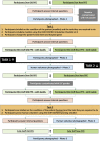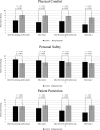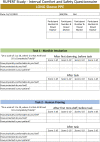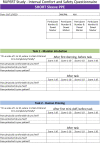Reduction in transfer of micro-organisms between patients and staff using short-sleeved gowns and hand/arm hygiene in intensive care during the COVID-19 pandemic: A simulation-based randomised trial
- PMID: 37744071
- PMCID: PMC10515327
- DOI: 10.1177/17511437221116472
Reduction in transfer of micro-organisms between patients and staff using short-sleeved gowns and hand/arm hygiene in intensive care during the COVID-19 pandemic: A simulation-based randomised trial
Abstract
Background: Current personal protective equipment (PPE) practices in UK intensive care units involve "sessional" use of long-sleeved gowns, risking nosocomial infection transmitted via gown sleeves. Data from the first wave of the COVID19 pandemic demonstrated that these changes in infection prevention and control protocols were associated with an increase in healthcare associated bloodstream infections. We therefore explored the use of a protocol using short-sleeved gowns with hand and arm hygiene to reduce this risk.
Methods: ICU staff were trained in wearing short-sleeved gowns and using a specific hand and arm washing technique between patients (experimental protocol). They then underwent simulation training, performing COVID-19 intubation and proning tasks using either experimental protocol or the standard (long-sleeved) control protocol. Fluorescent powder was used to simulate microbial contamination, detected using photographs under ultraviolet light. Teams were randomised to use control or experimental PPE first. During the simulation, staff were questioned on their feelings about personal safety, comfort and patient safety.
Results: Sixty-eight staff and 17 proning volunteers were studied. Experimental PPE completely prevented staff contamination during COVID-19 intubation, whereas this occurred in 30/67 staff wearing control PPE (p = .003, McNemar). Proning volunteers were contaminated by staff in 15/17 control sessions and in 1/17 with experimental PPE (p = .023 McNemar). Staff comfort was superior with experimental PPE (p< .001, Wilcoxon). Their personal safety perception was initially higher with control PPE, but changed towards neutrality during sessions (p < .001 start, 0.068 end). Their impressions of patient safety were initially similar (p = .87), but finished strongly in favour of experimental PPE (p < .001).
Conclusions: Short-sleeved gowns with hand and forearm cleansing appear superior to sessional long-sleeved gowns in preventing cross-contamination between staff and patients.
Keywords: COVID19; infection control; intensive care; personal protective equipment; simulation.
© The Intensive Care Society 2022.
Conflict of interest statement
The author(s) declared no potential conflicts of interest with respect to the research, authorship, and/or publication of this article.
Figures







Similar articles
-
Unintended consequences of long-sleeved gowns in a critical care setting during the COVID-19 pandemic.J Hosp Infect. 2020 Nov;106(3):605-609. doi: 10.1016/j.jhin.2020.07.036. Epub 2020 Jul 31. J Hosp Infect. 2020. PMID: 32745589 Free PMC article.
-
Personal protective equipment for preventing highly infectious diseases due to exposure to contaminated body fluids in healthcare staff.Cochrane Database Syst Rev. 2019 Jul 1;7(7):CD011621. doi: 10.1002/14651858.CD011621.pub3. Cochrane Database Syst Rev. 2019. Update in: Cochrane Database Syst Rev. 2020 Apr 15;4:CD011621. doi: 10.1002/14651858.CD011621.pub4. PMID: 31259389 Free PMC article. Updated.
-
Sterilization of gowns: making the most of a scarce commodity during the COVID-19 pandemic.Public Health Action. 2021 Sep 21;11(3):112-113. doi: 10.5588/pha.21.0024. Public Health Action. 2021. PMID: 34567985 Free PMC article.
-
Self-contamination following removal of two personal protective equipment suits: a randomized, controlled, crossover simulation trial.J Hosp Infect. 2022 Jan;119:155-162. doi: 10.1016/j.jhin.2021.09.017. Epub 2021 Oct 2. J Hosp Infect. 2022. PMID: 34606932 Clinical Trial.
-
Rapid review and meta-analysis of the effectiveness of personal protective equipment for healthcare workers during the COVID-19 pandemic.Public Health Pract (Oxf). 2022 Dec;4:100280. doi: 10.1016/j.puhip.2022.100280. Epub 2022 Jun 13. Public Health Pract (Oxf). 2022. PMID: 35722539 Free PMC article. Review.
References
-
- UKHSA . COVID-19: personal protective equipment use for aerosol generating procedures. 2020. Available from: https://www.gov.uk/government/publications/covid-19-personal-protective-... (Accessed 22nd January 2021).
LinkOut - more resources
Full Text Sources
